In its 33rd edition this January, Tanztage Berlin 2024 put forward a selection of ten pieces by dance artists currently active in Berlin. The festival, which acts as a showcase for Berlin’s emerging dance artists, takes place in the historic Sophiensaele, a space founded in 1996 by artists, for artists and which is located in the former Craftsmen's Association House. From its inception, Sophiensaele has been dedicated to independent theatre and dance. It provides a space for artists and the public to engage in continuous dialogue and serves as a place to delve into current performances tendencies.
The programme, curated by Mateusz Szymanówka, is dedicated to examining the collective body as ‘it hardens and softens, freezes and fights, weakens and regains strength’. It was definitely able, in my opinion, to present pieces that in terms of format, aesthetics, and spatial arrangement, resonate with the necessity of a dialogue with the future and which face up to the precarious period in which we are living.
Tanztage also features discussions and workshops every year. In particular, the open discussion ‘Both Sun & Moon Come Out to Fuck Up Fascists. The Works isn’t Finished Until Fascism is Dead’ represented a particular empathy with the scene and the current critical political situation in Berlin. Like all of Germany, Berlin is going through a difficult time, accentuated by the rise of the far-right, muted pro-Palestinian voices, and growing anti-Semitism.
Participating in contemporary dance can be sometimes quite challenging, even if one has a trained eye, especially when talking about the work of emerging choreographers. I consider it a great responsibility on several levels, first of all towards the artists themselves. To confront myself with the work of a dance artist who is perhaps at the beginning of their career can be critical because, when the choreographic language is in the early stages of development I do not have many parameters for analytical understanding. On the other hand, it is important to take on the responsibility of 'discovery', perhaps to witness the emergence of stylistic figures and of choreographic content.
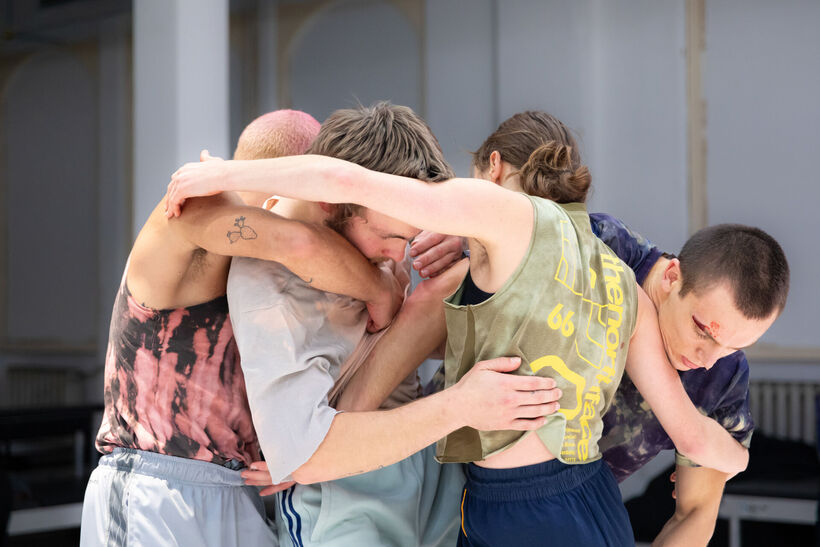
Breast to breast, Mythological Reinterpretation and a Salsa Vibe
In Fists to Flowers by Israeli born Yotam Peled & the Free Radicals, a quartet experiences the white space of the Hochzeitssaal (Wedding hall) as if it were a boxing ring, a place of encounter and confrontation. Peled has been based in Berlin since 2015 and the ensemble was established in September 2018. The four dancers are dressed in sporty and colourful rehearsal clothes. The white stage setting comprises four chairs positioned at the stage edges and, just like in a boxing match, the audience is positioned around it. For almost the entire duration of the performance, apart from the end, it is flooded fully with light. Almost immediately, the performers interact: first creating a rhythmic quartet, one in front of the other, almost mirroring one another, ending in a big embrace. Moments of intertwined and visceral duets, trios, and quartets alternate with individual explorations of space. The grammar of movement is that of animalistic floor work, characterised by body-beats and chest-to-chest intertwining. And it is precisely the choreographic group constructions, their compelling plastic forms and poses, that created the most incisive result. As if the dance could only exist in the embrace of different bodies, as if the encounter of individuals could generate movement, defeating the solitude of individuality.
The Faun by Argentinian artist Camila Malenchini and her dramaturgical team was based on the myth of the Faun (or Pan), an ancient Italic deity, human in form, with goat feet and horns, worshipped as a genie of the woods and a protector of flocks.
Positioned in the Festsaal (Banqueting hall), Sophiensaele’ main stage, the piece begins with a reinterpretation of the iconic choreography of Vaslav Nijinsky’s L’Après Midi d’un Faune (1912) by a solo dancer, before generating a new choreographic plot with the addition of two other performers in the role of fauns. When Nijinsky presented his version to a predominantly upper-class audience, it was disconcerting both because of the kind of movement used (radically different from the ballet aesthetic appreciated at the time), and above all because of the strongly sexual and animalistic theme. In the 21st century, Nijinsky’s piece still inspires many contemporary choreographers as a kind of milestone of avant-garde choreography.
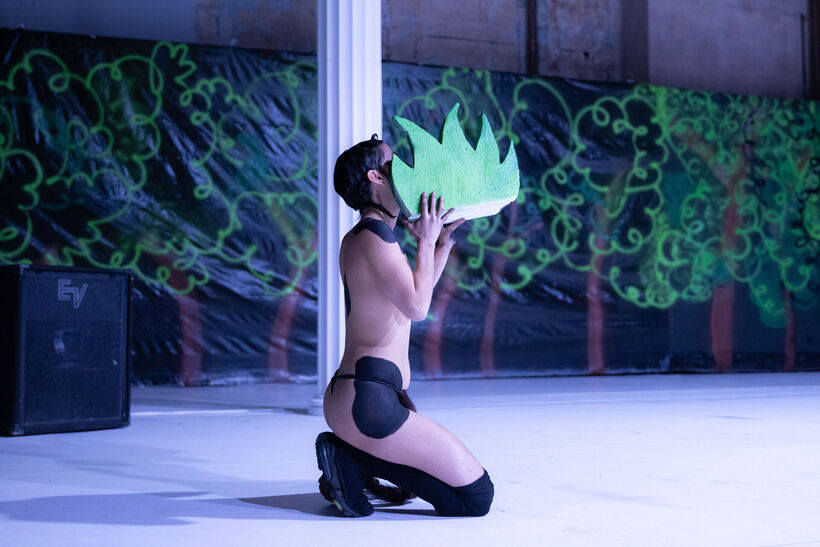
In Malenchini’s The Faun there are three bare-breasted fauns, dressed only in a thong and a long hair braid placed in front of the genitals, with black, spotted patches drawn on their skin, wearing black socks and high shoes, with strong, bright make-up on the face.
Following the reconstruction of Nijinsky’s choreography, the three fauns take their time to reappropriate the scene, crawling and leaving footprints on the floor with black ink. Then in the third and final phase, they return to being upright animals and spot themselves on stage with leaping steps and rhythmic sequences drawing spatial geometries, all bathed in red light. By freeing the beast, this scene takes on a power, almost that of a miniature rave.
Malenchini still chooses to approach the faun from a mythological perspective, considering it as a beast, through a gaze that is more than merely sexual. At the same time, she seems to be investigating the figure of the faun as an archetype. In fact, here it is played by three fauns, almost multiplying its potential, capable of reflecting the characteristics of human essence.
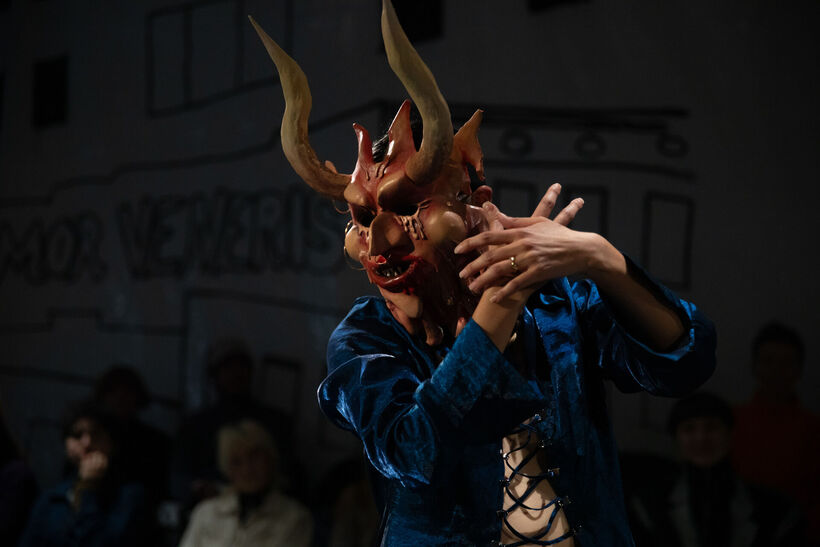
Finally, Colombian performance artist Juan Felipe Amaya Gonzalez invited the Tanztage Berlin audience to witness his piece Bravura. For three hours, during which the spectators could enter and exit as they wished, the Sophiensaele cantine was transformed into a salsa club, where a story of love, migration, and murder is represented by Luisa Fernanda Alfonso and Amaya Gonzalez himself. The light is dim. On one of the cans there is an active bar. On the opposite side is the station of DJ Arepabahn (Carlos Andrés Rico), who, as we later discover, also acts as the narrator of the story. The floor is sticky. Hanging on the walls are white plastic sheets with abstract drawings by Matti Schulz.
Bravura is organised into three acts: the first perhaps in Cuba or Puerto Rico, the second and third in a New York club. The set also includes two demonic masks that the two performers wear at the beginning of the two main acts. During the pauses, the audience is invited to move around, dance, and drink.
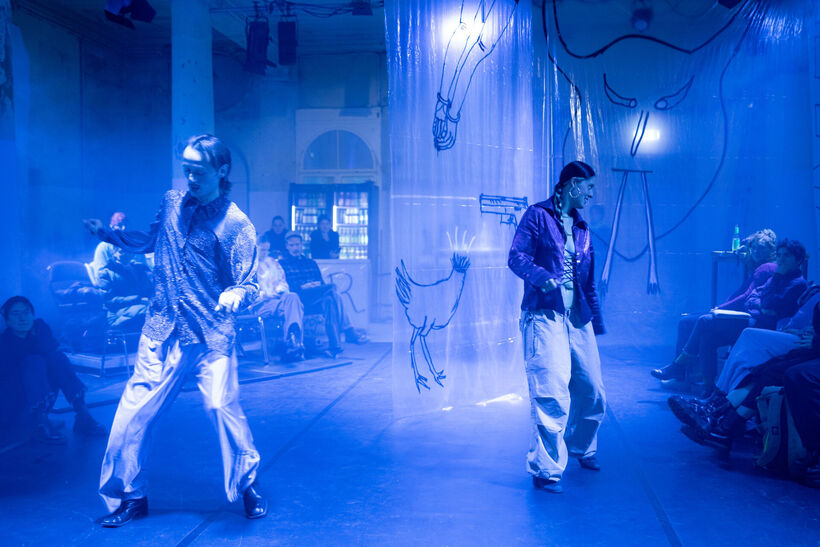
Even though the theatrical dramaturgical structure is the primary device employed, the language is clearly that of dance. Influenced by salsa, (and here I learn that there are different types of salsa such as sensual or romantica) it is open to contamination by contemporary dance. In the final act, the two protagonists, bare-breasted and wearing shiny trousers, begin a touching duet, standing almost intertwined, which then becomes a lively salsa, and finally opens up to include the audience in the dance. Here I felt that the duet was too short, almost interrupted, and I would have liked to have been able to savour some more of it before celebrating with them through collective ballroom movement.
Dedicated to those who are no longer with us and celebrating them through salsa vibes, Amaya Gonzalez processes an anthropological genre of dance (salsa) into an aesthetic and dramaturgical artefact, a visceral choreographic and theatrical exploration that resonates with the everlasting need to enter into a dialogue with life and death.
Written from the performances of the 13 and 20 January 2024 at Tanztage Berlin, 2024 in Sophiensaele, Berlin.
Fists to Flowers
Concept, choreography, Performance: Yotam Peled
Performance: Erin O’Reilly, Andrius Nekrasovas, Nicolas Knipping
Light design: Hanna Kritten Tangsoo
Documentation: Valentin Braun
Production management: Sofia Fantuzzi
Communication, distribution: Laia Monyota / TINA agency
The Faun
Concept, direction: Camila Malenchini
Performance: Layton Lachman, Ron Berger, Camila Malenchini
Dramaturgical support: Louise Trueheart, Dandan Liu
Special guest: Rara
Sound design: Fjola Gautadóttir
Sound support: Andrea Parolin
Light design: Arta de Mi
Set design: Camila Malenchini
Support set design: Thais Ribeiro
Costume: Anne Marina Fidler
Artistic support: Sarah Parolin, Auro Orso, Marga Alfeirão
Vocal coaching: Harald Stojan
Bravura
Concept, direction: Juan Felipe Amaya Gonzalez (jfag)
Performance: Juan Felipe Amaya Gonzalez (jfag), Luisa Fernanda Alfonso, Carlos Andrés Rico
Music composition: Carlos Andrés Rico (aka DJ Arepabahn)
Set/installation: Matti Schulz
Art direction and costume: Luisa Fernanda Rodríguez Jiménez (aka Mujer Cobra)
Mask consultant: Sofia Loose Martínez De Castro
Light design: Emilio Cordero Checa
Dramaturgical support: Dandan Liu

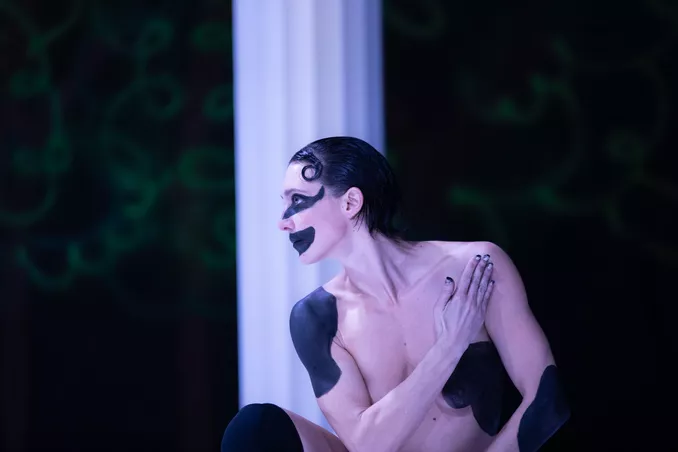



Josef Bartos
Thank you for your thoughts. One got stuck in my mind – that passion makes us different from AI. Just yesterday I read…I am a dance critic. I am a member of an endangered species